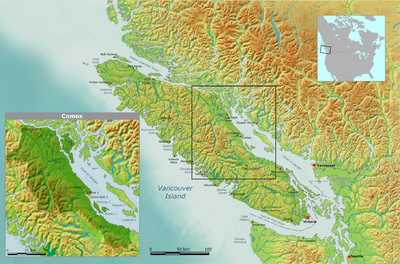
Comox people
Encyclopedia

- This article refers to the Comox people. For other uses please see the disambiguation page at ComoxComoxComox is a name from the Kwak'wala language, meaning "plenty" and "riches". The Kwakwaka'wakw people of British Columbia, Canada applied it as a metonym to the Salish people living in the area of the present-day town of the same name...
.
The Komox people, usually known in English as the Comox people and also spelled K'omoks, are an indigenous
Indigenous peoples of the Pacific Northwest Coast
The Indigenous peoples of the Pacific Northwest Coast are the pre-Columbian inhabitants of the Pacific Northwest Coast, their descendants, and many ethnic groups who identify with those historical peoples. They are now situated within the Canadian Province of British Columbia and the U.S...
group of Coast Salishan-speaking people in Comox
Comox
Comox is a name from the Kwak'wala language, meaning "plenty" and "riches". The Kwakwaka'wakw people of British Columbia, Canada applied it as a metonym to the Salish people living in the area of the present-day town of the same name...
, British Columbia
British Columbia
British Columbia is the westernmost of Canada's provinces and is known for its natural beauty, as reflected in its Latin motto, Splendor sine occasu . Its name was chosen by Queen Victoria in 1858...
and in the Toba Inlet
Toba Inlet
Toba Inlet is one of the lesser, but still principal, inlets of the British Columbia Coast. It is fourth in the series north from the 49th parallel which begins with Burrard Inlet, which is the harbour for the city of Vancouver...
and Malaspina Peninsula
Malaspina Peninsula
The Malaspina Peninsula is a peninsula in the northern Gulf of Georgia-Sunshine Coast region of British Columbia, Canada. It extends northwest from the town of Powell River, which lies near its isthmus, past the settlement of Lund, to Desolation Sound...
areas of the British Columbia mainland across Georgia Strait. Those at the town of Comox are known as the Island Comox, those across the strait are known as the Mainland Comox and are formed of two groups, the Sliammon and the Klahoose. They historically spoke the Komox language, which is divided into two dialects, Island Comox and Mainland Comox. The Island Comox have close ties to the Lekwildok or Southern Kwakiutl of Campbell River
Campbell River, British Columbia
Campbell River is a coastal city in British Columbia on the east coast of Vancouver Island at the south end of Discovery Passage, which lies along the important coastal Inside Passage shipping route...
and Quadra Island
Quadra Island
Quadra Island is an island off the eastern coast of Vancouver Island, British Columbia, Canada, part of the Discovery Islands. It is separated from Vancouver Island by Discovery Passage, and from Cortes Island by Sutil Channel...
.
Governments
Modern-day Komox are organized in four band governments:- K'ómoks First NationK'ómoks First NationThe K'ómoks First Nation, also known as the Comox Indian Band, is the band government of the Island Comox or K'ómoks people of Vancouver Island, British Columbia, Canada. Closely allied to the Cape Mudge and Campbell River First Nations, historically they were a Coast Salish people since...
(Vancouver Island) - Sliammon First NationSliammon First NationThe Sliammon First Nation or Tla A'min First Nation is a First Nations government located on the upper Sunshine Coast in southwestern British Columbia, Canada...
(Powell River/Malaspina Peninsula) - Klahoose First NationKlahoose First NationThe Klahoose First Nation is a First Nations government located on Cortes Island at the northern end of the Strait of Georgia, and surrounding Toba Inlet, in southwestern British Columbia, Canada...
(Discovery Islands) - Homalhco First Nation (Toba Inlet)
See also
- ComancheComancheThe Comanche are a Native American ethnic group whose historic range consisted of present-day eastern New Mexico, southern Colorado, northeastern Arizona, southern Kansas, all of Oklahoma, and most of northwest Texas. Historically, the Comanches were hunter-gatherers, with a typical Plains Indian...
- ComancheriaComancheriaThe Comancheria is the name commonly given to the region of New Mexico, west Texas and nearby areas occupied by the Comanche before the 1860s.-Geography:...
- ComoComoComo is a city and comune in Lombardy, Italy.It is the administrative capital of the Province of Como....
- Como Province
- Como Lake
- Mount KamonKamonKamon may refer to:*Kamon , a Japanese heraldic symbol*Kamon, Israel, a village in northern Israel-See also:*Kimon, an Athenian politician and general...
- EskimoEskimoEskimos or Inuit–Yupik peoples are indigenous peoples who have traditionally inhabited the circumpolar region from eastern Siberia , across Alaska , Canada, and Greenland....
- KomiKomiThe name Komi may refer to:*Komi Republic, a republic in Russia**Komi peoples**Komi language, languages of the Komi peoples *Komi, a short name for komidashi, a rule used in the board game Go...
- Kumo XiKumo XiThe Kumo Xi ) were a Mongolic steppe people located in current Manchuria from 207 AD to 907 AD. After the death of their ancestor Tadun in 207 they were no longer called Wuhuan but joined the Khitan Xianbei in submitting to the Yuwen Xianbei. Their history is widely linked to the more famous Khitan...
- Emperor KōmeiEmperor Komeiwas the 121st emperor of Japan, according to the traditional order of succession. Kōmei's reign spanned the years from 1846 through 1867.-Genealogy:Before Kōmei's accession to the Chrysanthemum Throne, his personal name was ;, his title was ....
- Emperor KammuEmperor Kammuwas the 50th emperor of Japan, according to the traditional order of succession. Kammu reigned from 781 to 806.-Traditional narrative:Kammu's personal name was . He was the eldest son of Prince Shirakabe , and was born prior to Shirakabe's ascension to the throne...

